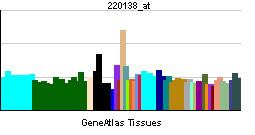Entrez 9421 | Ensembl ENSG00000113196 | |
 | ||
Aliases HAND1, Hxt, Thing1, bHLHa27, eHand, heart and neural crest derivatives expressed 1 External IDs MGI: 103577 HomoloGene: 3545 GeneCards: HAND1 | ||
Heart- and neural crest derivatives-expressed protein 1 is a protein that in humans is encoded by the HAND1 gene.
Function
The protein encoded by this gene belongs to the basic helix-loop-helix family of transcription factors. This gene product is one of two closely related family members, the HAND proteins are expressed within the developing ventricular chambers, cardiac neural crest, endocardium (HAND2 only) and epicardium (HAND2 only) . HAND1 is expressed with myocardium of the primary heart field and plays an essential but poorly understood role in cardiac morphogenesis.
HAND1 works jointly with HAND2 in cardiac development of embryos based on a crucial HAND gene dosage system. If HAND1 is over or under expressed then morphological abnormalities can form; most notable are cleft lips and palates. Expression was modeled with a knock-in of phosphorylation to turn on and off gene expression which induced the craniofacial abnormalities. Knock-out experimentation on mice caused death and severe cardiac malformations such as failed cardiac looping, impaired ventricular development and defective chamber septation. This aids in the implication that HAND1 expression is a factor to patients suffering from congenital heart disease. However, a lack of HAND1 in the distal regions of the Neural Crest has no effect on cranial feature formation. Mutation of HAND1 has been shown to hinder the effect of GATA4, another vital cardiac transcription factor, and is associated with congenital heart disease. The lack of HAND1 detection in the developing embryo leads to many of the structural defects that causes heart disease and facial deformities while the dosage of HAND1 relates to the severity of these maladies.
HAND factors function in the formation of the right ventricle, left ventricle, aortic arch arteries, epicardium, and endocardium implicating them as mediators of congenital heart disease. In addition, HAND1 is uniquely expressed in trophoblasts and is essential for early trophoblast differentiation.
